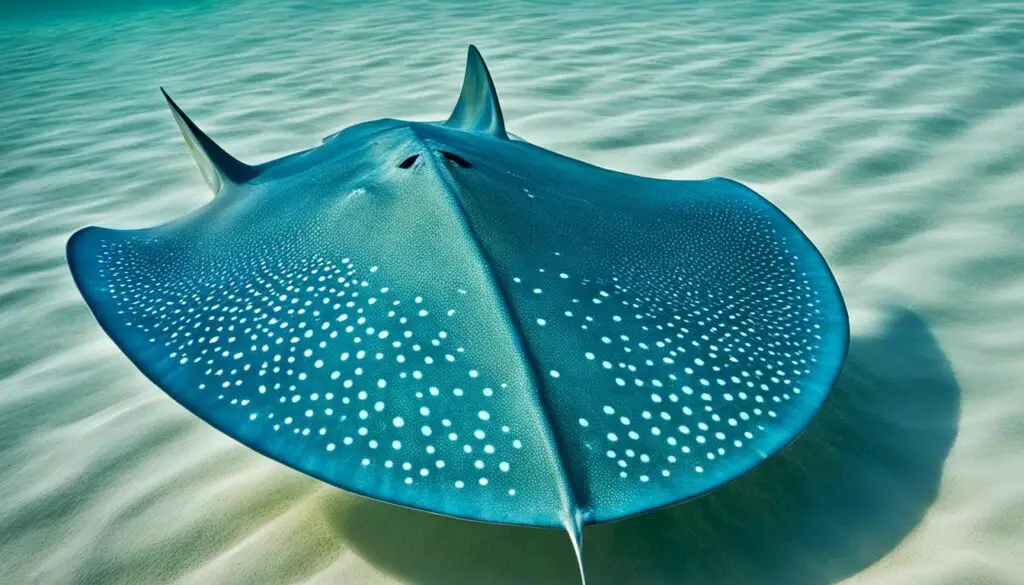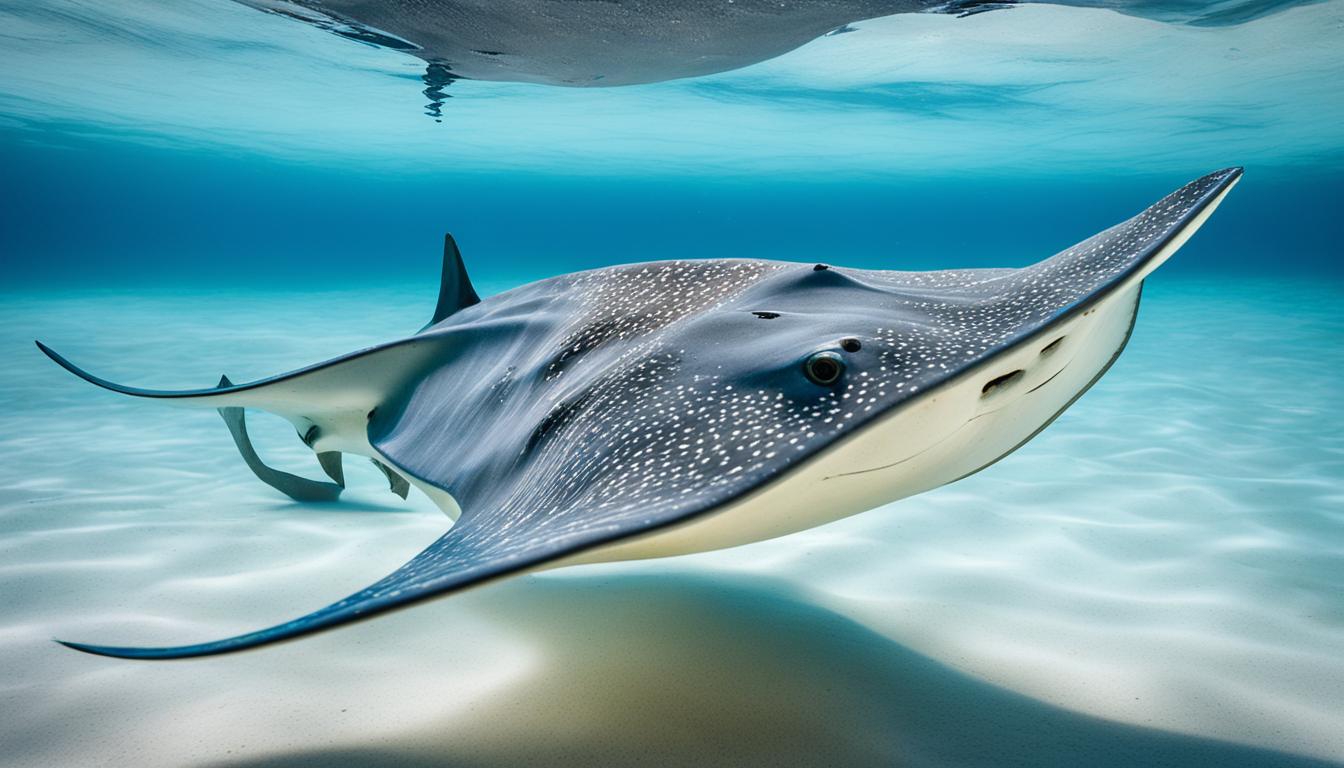Ever wondered how stingrays move through the water? Their swimming techniques are quite fascinating. These marine animals use their broad bodies and special fins to glide smoothly through the sea. This lets them move well in different underwater places.
Stingrays have evolved to be very good at swimming. Their bodies are shaped in a way that helps them move through the water easily. They use their fins to control their direction and speed. This makes them very efficient swimmers.
Stingrays play a big role in the ocean. They help keep the ecosystem balanced by controlling the number of other sea creatures. By learning how they swim, we can understand more about their lives and how they fit into the ocean.
Understanding Stingray Anatomy
Stingrays have a unique anatomy that combines function and adaptability. Their design is perfect for their life in the water. They have features that help them survive and thrive in their environment.
Body Shape and Structure
The stingray’s body is flat and rounded, making it great for swimming. This shape helps them hide on the ocean floor from predators. It also protects them and makes it easier to move through the water.
Fins and Their Functionality
Stingrays have big pectoral fins that cover their body. These fins are key for how they move. They can move like wings to swim or flap them to steer and balance in the water.
Stingray Skeleton Composition
Stingrays don’t have a typical fish skeleton. Instead, they have one made of cartilage. This cartilage makes them flexible and agile. It lets them move well in different water conditions.
How do stingrays swim?
Stingrays have amazing ways of swimming, thanks to their special techniques. These skills help them move through the water well. Learning about these methods helps us understand how stingrays swim, making us appreciate them more.
Unique Swimming Techniques
Stingrays use two main ways to move: wavy motion and flapping fins. Each method has its own purpose and shows how adaptable they are.
Wavy Motion vs. Flapping Fins
The wavy motion is a smooth, wave-like movement that helps stingrays move forward. It lets them glide through the water smoothly, using the ocean’s currents to their benefit. On the other hand, flapping fins make them go fast, which is important for catching prey and avoiding danger.
Stingray Movement Patterns
Stingrays move in ways that show their amazing adaptations and behaviors. They have special traits that help them move in the water. These traits make them experts in their underwater world.
Adaptations for Aquatic Movement
Stingrays have special features that help them move smoothly in the water. Their flat bodies and wide fins let them glide over the ocean floor. This shape helps them swim and move easily in their home.
Their skin blends in with the surroundings, hiding them from predators. This is key for hunting and staying safe.
Behavior in Shallow Waters
In shallow waters, stingrays show off their unique behavior. They dig into the sand to surprise their prey. This trick keeps them safe from big predators and helps them find food in the sand.
This way of moving makes them great hunters in places where it’s hard to see. They use their special senses to find food even when it’s hidden.
| Adaptation | Function |
|---|---|
| Flattened Body | Facilitates gliding and quick movements across the ocean floor |
| Broad Fins | Enhances propulsion and maneuverability in various water depths |
| Camouflaged Skin | Aids in hiding from predators and stalking prey |
| Electroreceptors | Detects hidden prey beneath the sand |
Stingray Locomotion Explained
Stingrays move through water using special ways that help them survive. They control their speed and adapt to different water environments. This makes their movement strategies fascinating.
Propulsion Mechanisms in Action
Stingrays move with their wide pectoral fins. These fins flap or move in waves to push them forward. This method lets them change how they swim based on the water.
How Stingrays Control Their Speed
Being able to control their speed is key for stingrays. They can speed up or slow down by changing how their fins move. This helps them move quickly when needed and save energy when not.
| Propulsion Mechanism | Swimming Technique | Speed Control Strategy |
|---|---|---|
| Pectoral fin flapping | Gliding | Slow, energy-efficient |
| Pectoral fin undulation | Rapid movement | Quick acceleration |
| Body undulation | Turning or maneuvering | Adjusts direction smoothly |
Stingray Swimming Behavior
Stingrays are often thought to be alone, but they have interesting social lives. They come together during breeding seasons and migrations. This shows how they interact with each other.
Social Interactions and Group Swimming
Some stingrays gather in groups, especially for mating. This group swimming is important for their survival. During these times, they work together to reproduce.
You might see thousands of stingrays moving together during migrations. This shows how they are connected and work as a group.
Migration Patterns of Various Species
Stingrays migrate for different reasons, like finding warm water or food. They change their paths based on the weather and food availability. This shows how they adapt to their environment.
Stingray Swimming Mechanics
The way stingrays swim is a blend of muscle movement and hydrodynamics. These elements work together to make their swimming efficient. This helps them move through different types of water.
Muscle Movement and Coordination
Stingrays have a special muscle setup for swimming. This setup helps their fins and body move together smoothly. When swimming, certain muscles work together to make a smooth motion through the water.
This movement is key for staying stable and swimming efficiently. It lets stingrays swim long distances without getting tired.
The Role of Hydrodynamics in Swimming
Hydrodynamics is very important for stingray swimming. Their bodies are shaped to cut through water easily. Their fins also help them move better in the water.
As water moves over them, it creates lift and reduces drag. This makes them swim more efficiently. Learning about these hydrodynamic principles helps us understand how stingrays and other sea creatures move.

| Aspect | Details |
|---|---|
| Muscle Movement | Involves coordinated contractions for efficient movement. |
| Swimming Coordination | Synchronization of body and fin movements allows streamlined motion. |
| Hydrodynamics | Streamlined shape reduces resistance and enhances glide. |
| Swim Efficiency | Energy conservation through optimal muscle function and body design. |
| Aquatic Biomechanics | Study of movements in water, critical for understanding performance. |
Stingray Swimming Habits
Stingrays have unique ways of swimming that help them hunt and reproduce. These habits show how they’ve adapted over time. They help them survive in different water environments.
Feeding Techniques and Strategies
Stingrays have smart ways to catch their food. They eat clams, shrimps, and small fish. Their mouth is on the bottom, letting them suck in prey easily.
After catching prey, stingrays use strong jaws to break open shells. This shows how they’ve adapted to eat their diet. It’s key for their health and survival.
Reproductive Swimming Behaviors
During mating, stingrays show special swimming patterns. These patterns are key to their mating rituals. Most stingrays have a unique way of reproducing, giving birth to live young.
This method affects their breeding habits and helps their species survive.
Conservation Impacts on Stingray Swimming
Understanding how conservation affects stingray populations is key to their survival. Stingrays face threats like overfishing, habitat loss, and climate change. These threats change their swimming and behavior, showing how important healthy ecosystems are.
Conservation efforts aim to reduce these threats. They focus on protecting their homes and spreading awareness about stingrays’ role in the ocean. By protecting their homes, we help stingrays live and swim as they should. More conservation work means better water quality and saved habitats for stingrays to move and find food.
Your support for conservation helps make environments where stingrays can thrive. As their homes become less disrupted, their swimming and social life will get better. This shows how marine life is connected. Supporting conservation helps stingrays and keeps the oceans healthy.










